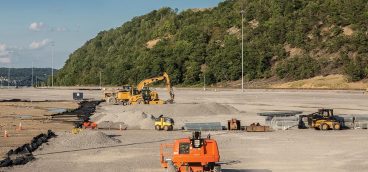
The conversations began quietly two years ago in Pittsburgh and Harrisburg. Could natural gas be harvested from shale without writing a new chapter in the legacy of tainted air and water that had been the price of nearly a century of steel making and mining in the region? And was there an appetite among energy companies and environmentalists for working together to find ways to do it?
From Harrisburg, John Hanger was contacting companies and environmental nonprofits he felt were willing to collaborate on trying to take environmental damage out of the equation in the shale fields of Pennsylvania, Ohio and West Virginia through continuous improvement of drilling practices beyond what is required by regulation. His previous jobs as a Pennsylvania public utilities commissioner, director of a statewide environmental nonprofit and, most recently, Secretary of the Pennsylvania Department of Environmental Protection gave him a sense of those who took the long view of gas development. He also had a sense of who was amenable to creating a corporate culture that considers environmental safety a value rather than a liability, which he considered crucial, knowing what he did about the limitations of regulation.
“Strong regulation helps build a culture of safety,” Hanger says. “But regulators can only do so much, even if they’re doing their jobs well. They don’t drive the trucks or do the hydraulic fracturing, and they’re not there 24 hours a day, seven days a week, the way that employees of companies are. How each company involved in the industry operates is a big factor in whether gas drilling is done with the least risk and lowest impacts possible.”
Even with hand-picked partners, the idea that a working group with disparate perspectives would last, let alone reach consensus on contentious issues involving shale gas drilling, was, in the words of Chevron Vice President Bruce Niemeyer, “a bit of a long putt.” Yet, nearly two years later, four major energy companies with substantial stakes in Marcellus and Utica shale gas remain at the table, engaged in discussions with five national, state and regional environmental organizations and two foundations. In March, the consortium, known as the Center for Sustainable Shale Development (CSSD), announced agreement on 15 environmental performance standards for shale gas development that, in large part, exceed regulatory requirements found in the Appalachian Basin states. And unlike many industry best practices programs, companies that adopt the standards are awarded certification only if they earn a passing grade for compliance from an independent auditor. A verdict on whether CSSD will succeed beyond those accomplishments won’t be handed down for some time. It will be at least a few months before any of the founding partner companies are ready to apply for certification. And they represent a fraction of the region’s gas-producing companies, most of which remain on the sidelines while they assess the standards and what certification might mean in the highly competitive industry. The Marcellus Shale Coalition, the region’s largest shale gas trade group, has yet to clarify its position on the CSSD. And the CSSD has drawn fire from some non-member environmental organizations, particularly over the fact that the agreed-upon drilling standards don’t carry the weight of law.
But it has gotten considerable attention, even in places as far away as Paris, where announcement of the standards created a buzz at the International Energy Agency meeting in March on unconventional natural gas. On this side of the Atlantic, several newspapers, including the Pittsburgh Post-Gazette, Dallas Morning News and Washington Post, responded with editorials applauding the coalition as a long-overdue step toward bridging ideological differences and addressing the environmental safety concerns at the heart of the shale gas controversy.
“Sit down at the table with someone who has a different point of view? God forbid. That’s kind of counterculture these days,” says Bobby Vagt, president of The Heinz Endowments, another CSSD founding partner and one of its philanthropic funders.
An assembly of ‘a’ students
Months before the CSSD took shape, Heinz Endowments officials—independent of Hanger’s efforts—had begun holding talks of their own with energy companies and environmentalists in Pittsburgh, testing the waters for a similar collaborative around improving the environmental performance of shale gas drillers. The Endowments has invested millions to address regional environmental and economic development issues.
“We felt philanthropy had a role in this and not just all about funding,” Vagt says. “It’s a huge issue, and our mission is to look at those things that have potentially serious consequences for the region and, most importantly, for the people of the region.” No one was naïve enough to think that persuading energy companies and environmentalists to roll up their sleeves and reach consensus on something as polarizing as shale gas drilling was going to be easy. If it had any chance of working, Hanger reasoned, the initial invitees had to be willing to tolerate divergent points of view and rely on science and facts as guidance rather than dogma and rhetoric. Companies on the short list had already begun improving their environmental practices.
“This is about excellence,” Hanger says. “It’s about establishing elite performance. Initially, it was important to have people in the industry and the NGO [nongovernmental organization] community who bought into that. This is about the A student.”
Three gas producers declined the offer or bowed out shortly after talks began. Four others—CONSOL Energy, EQT Corp., Chevron and Shell—signed up and have stayed the course. They are working with the Environmental Defense Fund, Clean Air Task Force, Citizens for Pennsylvania’s Future, Pennsylvania Environmental Council and the Group Against Smog and Pollution. The William Penn Foundation joined The Heinz Endowments as the group’s philanthropic partners.
The decision to participate was something even the A students had to think about. Does such a coalition stand a chance of succeeding was a question some debated internally. Would extreme views on either side of the issues dominate conversation? Would the coalition result in specific, verifiable actions that would improve industry performance? And there are risks associated with something like the CSSD, particularly for companies. Failure of the coalition could be seen as industry unwillingness to adopt tough measures to protect air, water and health.
But companies and environmental nonprofits both had powerful motives to raise the level of environmental protection within the shale gas industry.
For companies, industry performance stands out as a critical factor in maintaining their access to the abundant natural gas trapped in Appalachian Basin shale. “There’s an ongoing risk,” says CONSOL Energy President Nicholas DeIuliis. “If we can’t perform in a safe and environmentally compliant manner, we lose our social license to operate.” Another concern is that politics and rhetoric will trump science in the public debate over shale gas. In his view, the CSSD is an opportunity to keep the discussion of drilling practices focused on science.
Companies need only to look across Pennsylvania’s northern border to see how concerns over gas drilling and fracking, in particular, can trickle into public policy and cut off access. In March, the New York State Assembly extended by two years a fracking moratorium that was first imposed in 2008. And eight in 10 Greater Pittsburgh residents believe drilling poses at least a slight threat to the environment and public health, according to a survey done in 2011 by the University of Pittsburgh University Center for Urban and Social Research and PittsburghTODAY. Those concerns might be one reason why support for shale gas drilling is lukewarm despite the consensus that it offers economic opportunity. Some 45 percent of residents support drilling, 25 percent oppose it and the rest are on the fence. Yet no fewer than 90 percent believe it offers the region some level of economic opportunity.
“My take is that, as an industry, we didn’t anticipate the public’s need for transparency and got behind the curve,” says Andrew Place, the corporate director of energy and policy at EQT who is serving as the CSSD interim director until a full-term director is hired. “Hopefully, by saying ‘Here is the data, here’s what we are doing and here are the certification standards,’ this effort will help provide the assurances people have been longing for.”
Southwestern Pennsylvanians have good reason to want such assurances. The air in Allegheny County for the first time met annual limits for fine particulate pollution in 2011—some 40 years after the Clean Air Act was passed. And PittsburghTODAY water quality maps suggest effective stewardship of its waterways has not been the strong suit of the region, where more than 6,500 miles of rivers and streams fail to meet federal Clean Water Act standards for reasons ranging from abandoned mine drainage and urban runoff to industrial and wastewater effluent.
The risk that shale drilling could contribute to that legacy is not unfounded. Common concerns include: fugitive methane emissions; the potential for surface and groundwater contamination from salty water that accompanies gas to the surface; and the chemicals used in fracking fluids.
Few, if any, environmental nonprofits consider current drilling regulations sufficient to protect the environment against such threats. The example most cited is that fracking is exempted from regulation under the federal Safe Drinking Water Act. For the Boston-based Clean Air Task Force and a few others, the CSSD was seen as a chance to move closer to the day when adopting standards that exceed regulatory requirements becomes the industry norm.
“Our general philosophy is, where you can work with companies to advance the state of the art and improve practice, by all means do it. If you can’t, you have to revert to the adversarial approach, which we are equally comfortable with,” says Armond Cohen, executive director of the Clean Air Task Force. “We felt there is great value in having a group of companies agree to a set of higher standards. It disables the argument that companies can’t meet standards higher than the existing laws.”
Raising the bar
One of the first orders of business was to settle the issue of governance, which was handed to a board of directors that includes former U.S. Secretary of the Treasury and Alcoa Chairman and CEO Paul O’Neill, former Environmental Protection Agency Administrator Christine Todd Whitman and Jane Long, recently retired from the Lawrence Livermore National Laboratory, where her positions included associate director for Energy and Environment.
What followed was a nearly two-year, often challenging process of hammering out the initial set of performance standards intended to raise the bar on measures companies take to protect air and water quality when drilling for shale gas.
A key goal to emerge was zero contamination of surface and fresh groundwater. New standards toward that end, for instance, prohibit companies from discharging any wastewater into streams and rivers until the CSSD comes up with protocols for treatment. Other water standards require companies to disclose the chemical content of fracking fluids, do a risk analysis of subsurface geology before drilling, monitor surface water and aquifers within at least a 2,500-foot radius of a wellhead, use double-lined pits when holding drilling fluid, and, within two years, eliminate pits altogether in favor of a closed-loop system to contain drilling fluid and flowback water.
The standards prohibit the venting of gas into the atmosphere, place limits on flaring—burning off gas that isn’t captured—and restrict engine emissions from drilling rigs, pumps, compressors and other equipment. The standards also require companies to practice “green completion” starting in 2014, a year ahead of the EPA deadline. In that process, volatile organic compounds, methane and other gases that escape when a well first goes into production, are captured in a pipeline rather than vented or flared.
A key issue was how the CSSD would verify compliance. Environmental advocates insisted on having certification rest on the results of a compliance evaluation by independent auditors. The companies at the table didn’t object. “Everyone recognized pretty early that having someone independently validate that a standard was being met was important if this was going to have credibility,” says Niemeyer, vice president of Chevron’s Appalachian/ Michigan Business Unit.
Hanger was fairly confident that the first companies invited to the table saw value in improving their environmental and safety performance. In fact, they had a head start on implementing several of the first set of performance standards. CONSOL Energy, for example, already recycled produced water and flowback water, lined holding pits, and had discontinued the practice of venting gas emissions. Place estimates that EQT was using green completion on 80–85 percent of its new wells. Such practices also suggested that the companies saw the staffing, equipment and other out-of-pocket costs of raising their environmental performance as investments worth making.
“Doing the right thing doesn’t cost more money,” says former U.S. Treasury Secretary O’Neill. “Part of the reason people think it costs more money to do the right thing is because they don’t know the difference between accounting and economics. The fact that our accounting systems treat poisoned water as an externality doesn’t mean it doesn’t cost anything. We just don’t keep track of it. I believe really great companies take it upon themselves not to foist off externalities on the communities they’re in.”
The goal of raising industry standards for protecting air and water quality hasn’t shielded the CSSD from critics in the environmental NGO community, most notably the Sierra Club, the largest grassroots environmental organization in the country. Club officials declined to be interviewed for this article. But in an online statement, Deb Nardone, director of the club’s Beyond Natural Gas campaign, takes issue with the voluntary nature of CSSD certification, which, she argues, can’t replace rigorous regulation and enforcement. “Voluntary certification is akin to slapping a Band-Aid on a gaping wound. We know the oil and gas industry cannot be trusted to police itself, and we cannot afford to give a free pass to bad actors in the industry.”
The club’s history with the gas industry is complicated. A former executive director not long ago considered natural gas a “bridge fuel” to a cleaner energy future and from 2007 to 2010 the club quietly accepted $26 million in donations from shale gas producer Chesapeake Energy. It wasn’t until last year, after a Time magazine blog disclosed the donations, that the club acknowledged taking the money and was criticized by members and other environmental groups for doing so. The club has since changed its position on natural gas, which it no longer considers a “kinder, gentler” fuel, and supports moratoriums on fracking in New York and elsewhere.
The fact is, if Hanger had pitched the CSSD as a substitute for regulation, he’d have been hard-pressed to find any takers in the environmental community. “You can’t say regulation isn’t needed because a subset of companies have agreed to tighter standards,” Cohen says. “For starters, that leaves out all of the companies that aren’t in the certification process, which, at this point in Pennsylvania, is the majority.”
“Skepticism that voluntary efforts like this will lead to lasting value is legitimate. To some extent we’re skeptical too,” says Mark Brownstein, chief counsel of the U.S. Climate and Energy Program at the Environmental Defense Fund. “But we’re willing to take the chance that this could pay important dividends. Things like this underscore the importance of environmental performance by the standards they set and help advance the state of knowledge of what leading practices are. Regulations don’t always evolve quickly. Industry can often do better than what the regulations require because there’s a culture of innovation, particularly in shale gas. People are learning new stuff all the time about how to do things better and more efficiently.”
A question of buy-in
Perhaps most important to the success of the CSSD is whether more energy companies agree to adopt its standards and earn certification. It’s far too early to tell where that stands. The standards were only announced in March, and most companies are still assessing their implications.
The region’s largest shale gas trade group, the Marcellus Shale Coalition, has yet to endorse the initiative. And its position on the CSSD is unclear. A statement from CEO Kathryn Klaber reads: “We appreciate this diverse group’s support for our member companies’ development of natural gas and engaging in a process to embrace its clear environmental and public health benefits. This effort reflects an important recognition that current regulatory standards in Pennsylvania are protective of public health and the environment and our member companies are vigorously committed to compliance with this stringent framework.” Attempts to interview Klaber or anyone who might clarify the group’s position were unsuccessful.
With or without the support of other industry groups, wide acceptance of the CSSD standards will likely depend on how companies who’ve agreed to work toward certification perform and whether certification will become a competitive advantage for those companies. “I think it’s going to be very hard for companies not to be certified when others are,” says Hanger, who left the CSSD last year after announcing his intention to run for governor. “How is a company going to answer the question: Why are you not certified when Shell or Chevron or Consol or EQT is? The first people to ask that question should be the boards of directors of companies. And if I’m a landowner, I don’t want you drilling on my property if you can’t meet certification standards.”





